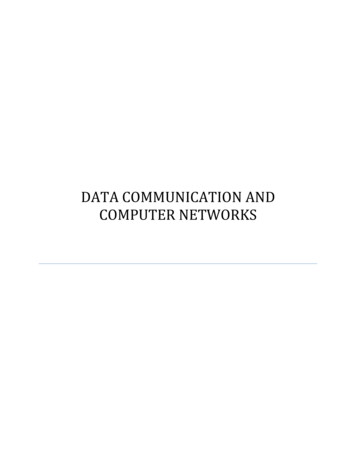
Transcription
Lecture 7:Data Center Networks"CSE 222A: Computer Communication NetworksAlex C. SnoerenThanks: Nick Feamster
Lecture 7 Overview" Project discussion Data Centers overview “Fat Tree” paper discussionCSE 222A – Lecture 7: Data Center Networks"2
Cloud Computing" Elastic resources Multi-tenancy Expand and contract resourcesPay-per-useInfrastructure on demandMultiple independent usersSecurity and resource isolationAmortize the cost of the (shared) infrastructureFlexibile service management Resiliency: isolate failure of servers and storageWorkload movement: move work to other locationsCSE 222A – Lecture 7: Data Center Networks"3
Cloud Service Models" Software as a Service (Saas) Platform as a Service (Paas) Provider licenses applications to users as a servicee.g., customer relationship management, email, Avoid costs of installation, maintenance, patches, Provider offers software platform for building applicationse.g., Google’s App-EngineAvoid worrying about scalability of platformInfrastructure as a Service (Iaas) Provider offers raw computing, storage, and networke.g., Amazon’s Elastic Computing Cloud (EC2)Avoid buying servers and estimating resource needsCSE 222A – Lecture 7: Data Center Networks"4
Multi-Tier Applications" Applications consist of tasks Many separate componentsRunning on different machinesFront end ServerCommodity computers Many general-purpose computersNot one big mainframeEasier scalingAggregator !AggregatorAggregatorAggregator !Worker5Worker !WorkerCSE 222A – Lecture 7: Data Center Networks"WorkerWorker
Host Virtualization" Multiple virtual machines on one physical machineApplications run unmodified as on real machineVM can migrate from one computer to anotherCSE 222A – Lecture 7: Data Center Networks"6
VMM Virtual Switches"CSE 222A – Lecture 7: Data Center Networks"7
Top-of-Rack Architecture" Rack of servers Modular design Commodity serversAnd top-of-rack switchPreconfigured racksPower, network, andstorage cablingAggregate to the next levelCSE 222A – Lecture 7: Data Center Networks"8
Extreme Modularity" Containers Many containersCSE 222A – Lecture 7: Data Center Networks"9
Data Center Challenges" Traffic load balanceSupport for VM migrationAchieving bisection bandwidthPower savings / CoolingNetwork management (provisioning)Security (dealing with multiple tenants)CSE 222A – Lecture 7: Data Center Networks"10"
Data Center Costs" James Hamilton published basic 2008 breakdown Servers: 45% Infrastructure: 25% UPS, cooling, power distributionPower draw: 15% CPU, memory, diskElectrical utility costsNetwork: 15% Switches, links, transitCSE 222A – Lecture 7: Data Center Networks"11
Traditional DC Topology"InternetCoreAggregationAccessData CenterLayer-3 routerLayer-2/3 switchLayer-2 switchServersCSE 222A – Lecture 7: Data Center Networks"12
DC Network Requirements" Scalability Incremental build out?Reliability Loop free forwarding VM migration Reasonable management burden Humans in the loop?CSE 222A – Lecture 7: Data Center Networks"13
Traditional Topologies" Over subscription of links higher up in the topology Tradeoff between cost and provisioning Single point of failureCSE 222A – Lecture 7: Data Center Networks"14
Capacity Bottlenecks"CR 200:1ARSCRARARARSSSSS 40:1SS 5:1A A ASS.A A ACSE 222A – Lecture 7: Data Center Networks"SA A ASA A A15
Management: L2 vs. L3" Ethernet switching (layer 2) IP routing (layer 3) Cheaper switch equipmentFixed addresses and auto-configurationSeamless mobility, migration, and failoverScalability through hierarchical addressingEfficiency through shortest-path routingMultipath routing through equal-cost multipathData centers often connect layer-2 islands by IP routersCSE 222A – Lecture 7: Data Center Networks"16
Advantages of Layer 2" Certain monitoring apps require server with same roleto be on the same VLAN Using same IP on dual homed servers Allows organic growth of server farms VM migration is easierCSE 222A – Lecture 7: Data Center Networks"17
Layer 2 Pods w/L3 Backbone"InternetCRDC-Layer 3DC-Layer 2S!SARARS!SS!SS!SS!SA A ACR.S!SA A A 1,000 servers/pod IP subnetCSE 222A – Lecture 7: Data Center Networks"ARAR.Key CR Core Router (L3) AR Access Router (L3) S Ethernet Switch (L2) A Rack of app. servers18
FAT Tree-Based Solution" An all Layer-3 solution Connect end-host together using a “fat-tree” topology Infrastructure consist of cheap devices» Each port supports same speed as endhostAll devices can transmit at line speed if packets are distributedalong existing pathsA k-port fat tree can support k3/4 hostsCSE 222A – Lecture 7: Data Center Networks"19
“Fat-Tree” Topology"CSE 222A – Lecture 7: Data Center Networks"20
Fat-Tree Challenges" Layer 3 will only use one of the existing equal costpathsPacket re-ordering occurs if layer 3 blindly takesadvantage of path diversity E.g., ECMPCSE 222A – Lecture 7: Data Center Networks"21
Modified Fat Tree" Enforce special addressing scheme in DC Allows host attached to same switch to route only throughswitchAllows inter-pod traffic to stay within podunused.PodNumber.switchnumber.EndhostUse two level look-ups to distribute traffic and maintainpacket ordering.CSE 222A – Lecture 7: Data Center Networks"22
Two-Level Lookups" First level is prefix lookup Used to route down the topology to endhostSecond level is a suffix lookup Used to route up towards coreDiffuses and spreads out trafficMaintains packet ordering by using the same ports for thesame endhostCSE 222A – Lecture 7: Data Center Networks"23
Diffusion Optimizations" Flow classification Eliminates local congestionAssign to traffic to ports on a per-flow basis instead of a perhost basisFlow scheduling Eliminates global congestionPrevent long lived flows from sharing the same linksAssign long lived flows to different linksCSE 222A – Lecture 7: Data Center Networks"24
Discussion" VM mobility Data center build out Internet connectivity Address space allocation Doing flow placement anyway?CSE 222A – Lecture 7: Data Center Networks"25
For Next Class " Read and review PortLand paper Work on project proposals Details posted to the web page this weekCSE 222A – Lecture 7: Data Center Networks"26
Host Virtualization" . CSE 222A – Lecture 7: Data Center Networks" 19 “Fat-Tree” Topology" CSE 222A – Lecture 7: Data Center Networks" 20. Fat-Tree Challenges" Layer 3 will only use one of the existing equal cost paths Packet re-ordering occurs if layer 3 blindly takes advantage of path diversity E.g., ECMP CSE 222A – Lecture 7: Data Center Networks" 21. Modified Fat Tree" Enforce .











